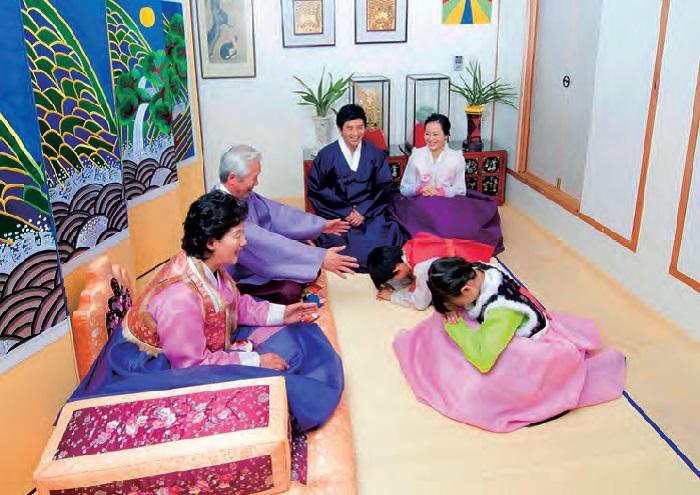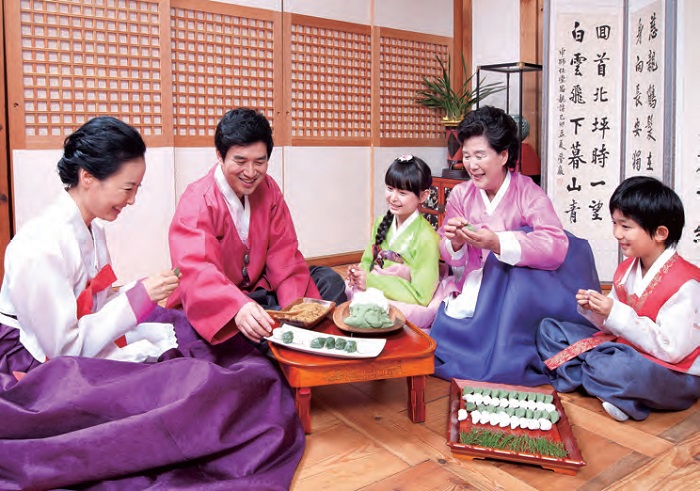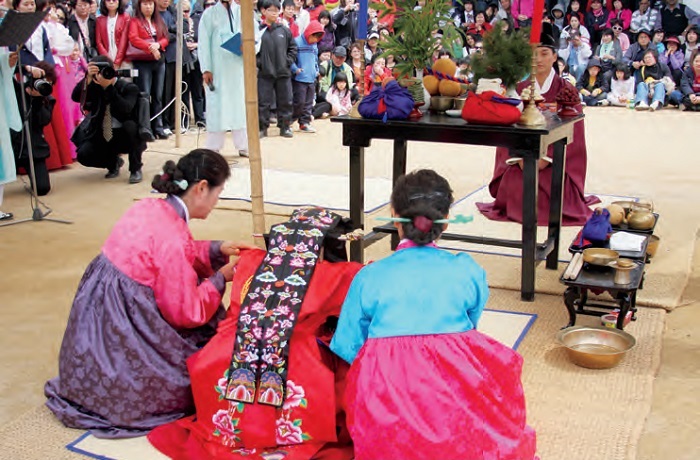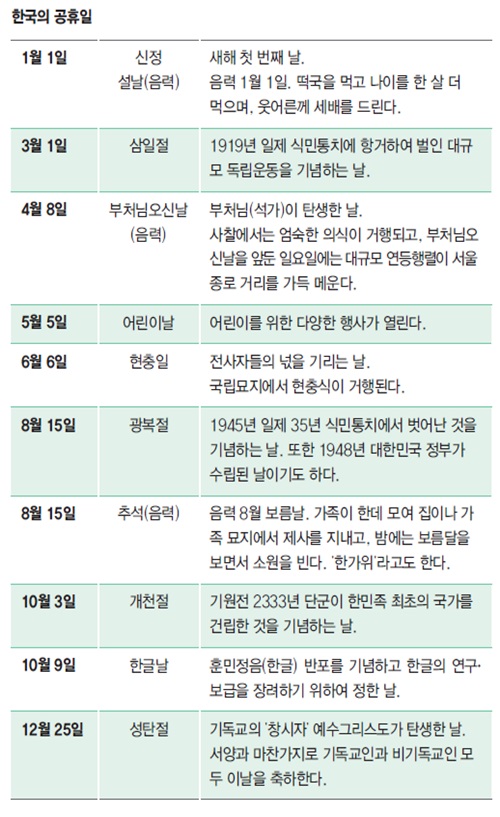The Lunar New Year’s Day (Seol or Seollal), which is generally regarded as the most important of all the traditional seasonal festivals, is celebrated with a special festival food called tteokguk, or “rice flake soup”. Eating it signified becoming one year older (this means that a child born on the 29th of the twelfth lunar month becomes two years old only two days later). The festival is also related with the ceremony of performing the Sebae (New Year’s Bow) before the elders of one’s family and neighborhood. After Sebae, the elders present New Year’s gift money to their juniors.
Another important seasonal festival called Daeboreum (Greater Full Moon) celebrates the fifteenth day of the first month of the year by the lunar calendar. On that day, people eat special festival food called ogokbap, a dish made with five grains and served with an assortment of cooked vegetables, play games aimed for the unity of the local community and perform rituals for good harvest. Chuseok, which is held on the fifteenth day of the eighth lunar month, consists of thanksgiving services in which newly harvested crops and fruits are offered to the ancestral spirits. Generally held to be as important as the Lunar New Year’s Day, Chuseok is also one of the two annuals occasions when all the family members gather together.

Sebae(New Year Bow). Korea has a long tradition of starting the New Year (by the lunar calendar) with the ceremonious bows made by children to their parents

Chuseok and Songpyeon. During the mid-autumn holiday of Chuseok (15th day of the 8th lunar month), families gather together and make songpyeon (half-moon shape rice cake).
Celebrations
Korean parents mark the one-hundredth day anniversary (baegil) and the first birthday (dol) of their baby with special big celebrations in which their families, relatives and friends participate. They generally hold a large celebratory banquet for their baby with a ritual prayer for the baby’s health, success in life, and longevity, and the participants give the baby gold rings as a special gift.
Weddings have also been a very important family celebration in Korea. Most Korean people today choose their own spouse according to their heart’s desire. In pre-modern times, however, husbands and wives were given by their parents or matchmakers after an examination of their horoscopic data, called Saju (Four Pillars of Destiny), which are determined by the hour and date of their birth. The tradition of consulting a diviner on their luck in the New Year and exchanging horoscopic data as part of the matchmaking process is still maintained by some families.

Traditional Wedding. The traditional Korean wedding ceremony largely consists of three stages: Jeonallye, in which the groom visits the bride’s family with a wooden goose; Gyobaerye, in which bride and groom exchange ceremonious bows; and Hapgeullye, where the marrying couple share a cup of wine. The photo shows a bride and groom exchanging ceremonious bows during the Gyobaerye stage of their wedding ceremony.
In the past, a wedding ceremony was an important village festival where the entire community would gather together to celebrate the young couple dressed in luxurious wedding robes and bejeweled headdresses. Today, the Western style of wedding ceremony is widely regarded as the norm, but some traditional rituals such as Pyebaek (traditional ceremony to pay respect to the groom's family by the newly-wedded couple right after their wedding) and Ibaji (wedding food that the bride presents to the groom's family) are still maintained.
In Korea, a baby becomes one year old as soon as she is born, and 60 years old on her 59th birthday. The age 60 has a profound meaning for Korean people as it signifies the completion of a sexagenary cycle. Someone who had reached the age of 60 was admired greatly as he or she was regarded as old enough to have experienced all the principles of heaven and earth. Today Korean men and women live much longer—about 80 years on average—than they did before and the 60th birthday is no longer celebrated in such a grand manner as it was previously.
National Holidays

In Korea there are five national holidays designated by the government: Independence Declaration Day (Samiljeol, March 1), which commemorates the March First Movement, one of the earliest public displays of Korean resistance against the Japanese occupation of Korea, and the promulgation of the Constitution of the Republic of Korea in 1948; Liberation Day (Gwangbokjeol, August 15), celebrating national liberation from Imperial Japan in 1945; National Foundation Day, which marks the foundation of Gojoseon, the first state of the Korean nation, on the 3rd day of 10th lunar month, 2333 BCE; and Hangeul Day (Hangeullal, October 9), which commemorates the invention and proclamation of the Korean writing system.
Public Holidays
The public holidays during which work is suspended by law in Korea include New Year’s Day, Seollal (or Lunar New Year’s Day, celebrated for 3 days), Chuseok (Mid-autumn Festival on the 15th day of the 8th lunar month, celebrated for 3 days), Buddha’s Birthday (on the 8th day of the 4th lunar month), Children’s Day (May 5), Memorial Day (June 6) and Christmas Day. There are fifteen public holidays in total on which businesses are closed by law and employees have a day off, from which Constitution Day is excluded.
http://www.korea.net/AboutKorea/Korean-Life/Festivals
Thank you for your guidance and support.Thank you for providing such a valuable information.
답글삭제Get together and enjoy the traditional foods and activities associated with this Korean Mid Autumn Festival.
답글삭제